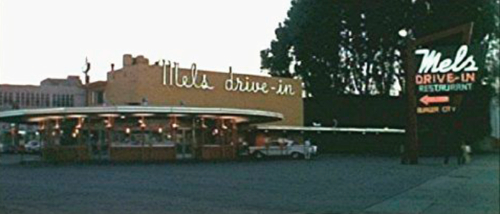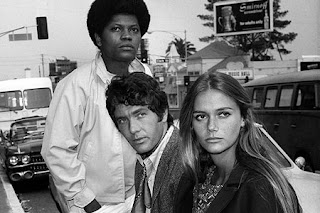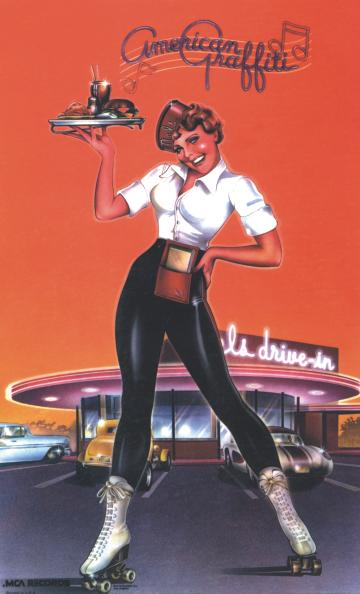Side 2 of 4 (Record 2)
Surfin' Safari: The Beach Boys (2:05)

The group consisted of three brothers, Carl, Dennis, and Brian Wilson, their cousin Mike Love and friend Al Jardine. Being the only boy who surfed in the band, Dennis thought the sport would be a great topic for a song and suggested it to Brian. Brian then wrote SURFIN SAFARI with cousin Mike. Nick Venet of Capitol records heard a demo of the song and signed the boys in June of 1962. The demo was then embellished with additional harmony parts and released as a single. On August 11, 1962, the tune reached number 14 and the B-side, a song about a hotrod called, 409 charted at number 76. The Beach Boys had taken two popular trends and turned them into a moneymaking formula that would last for several years. The Beach Boy's surfin' sound was new and different in 1962 and SURFIN' SAFARI underscores the fact that a new era was approaching and Milner (Paul LeMat) is unable or unwilling to change with it. He exclaims, "I hate that surfin' shit," and then quickly shuts off the radio. Then he adds, "Rock and Roll has been going down hill ever since Buddy Holly died."
He's The Great Imposter: The Fleetwoods (1:33)
This vocal group from Olympia Washington consisted of two females: Gretchen Christopher, and Barbara Ellis and one male, Gary Troxel. As was the case of many male vocalists, Troxel was drafted into the Navy in 1960. However, the group did not breakup, as many did,
 |
| The Fleetwoods |
once its male singer was in the military. The same year Troxel was drafted the band achieved a hit with RUNAROUND. After that, the Fleetwoods only recorded on Troxel's occasional leaves but still managed to score hits with songs like the beautiful smooth ballad, THE GREAT IMPOSTER, charting in 1961. The group had been prolific and recorded so much material before Troxel's service time that they were able to release five albums while he was in the service. In fact, one of their albums displays a picture of him in his uniform. In the film this song plays when Milner is trying to avoid another ticket by displaying false sincerity. He acts innocent and pretends to respect the law by being submissive and overly courteous to the officer who pulled him over (Jim Bohan).
 Almost Grown:
Chuck Berry (2:09)
Almost Grown:
Chuck Berry (2:09)
The debate of who had the first rock and roll record is an argument that may never be settled, but Berry's influence on rock music is unquestionable. His familiarity of the pop market allowed him to break color barriers and play to an integrated audience. The lyrics on ALMOST GROWN conveyed the attitude and sentiment of his teenage fans who felt oppressed by adults: DONT BOTHER ME LEAVE ME ALONE. ANYWAY IM ALMOST GROWN! The tune was on the charts for 39 weeks in 1959 reaching its peak at number thirteen. Trivia note: Etta James sings back up vocals on this one.
Smoke Gets in Your Eyes: The Platters (2:37)
Blessed with a sweet tenor named Tony Williams, the Platters helped immensely in putting black groups on the pop charts. The legendary ballad, "Smoke Gets in Your Eyes" was recorded in Paris, France when the group was touring there. The tune was originally a number one hit for Paul Whiteman in 1933-34. The song proved to be a blessing for The Platters as well when the tune reached number one on June 19, 1959 and held the position for 3 weeks. It is a sad moment for Laurie (Cindy Williams), in the film, when she expresses her feelings about her boyfriend, Steve (Ron Howard) flying back East for college. She feels he is abandoning her. As they dance quietly the lyrics to SMOKE GETS IN YOUR EYES can be distinctly heard, "Yet today my love has flown away, I am with-out___ my___ love." We see a tear falling from her eye because, "When a lovely flame dies, Smoke gets in your eyes."
 |
| The Diamonds |
Little Darlin': The Diamonds (2:04)
After Diamond's manger Nat Goodman heard the latest 45 record by Maurice Williams and the Gladiolas, he knew it was going to be a hit-for the Diamonds, that is. The song, was "Little Darlin'." He rehearsed the group to learn the tune and in the process the boys decided to exaggerate the bass and falsetto parts on the record. The music with its castanets, cowbells, electrifying Spanish rhythm guitar and thrilling piano gliss sounded like nothing else before it. Sounding like a turbo charged cha cha, Little Darlin' was an immediate hit when it was released in February of 1957 and the bass talking bridge has become one of the most memorable parts of 50s rock and roll history.
Peppermint Twist: Joey Dee and the Starliters (1:58)
In the film Curt tries to get the driver (Lynn Stewart) to follow the elusive woman in the white -T-Bird as she turns and "twists" out of sight leading him "round and round, up and down," and all over the streets of the small town. The Starliters who perform this catchy tune were discovered In 1960 by agent Don Davis who saw them playing at a Lodi, New Jersey nightclub called Oliveri's. The Starliters were booked to play a one-time weekend gig at a venue on 45th Street in New York City called the Peppermint Lounge. The band was such a success that they ended up becoming the house band for more than a year.
 |
| The Starliters |
As a tribute to the lounge "PEPPERMINT TWIST" was written by alto sax player/back up vocalist, Joey Dee and band producer, Henry Glover. While in the studio recording the tune lead singer, David Brigati couldn’t quite get the feel the producer was looking for so Joey Dee was asked to give it a try. Joey taking the lead turned out to be just what the song needed. The song was released and hit the top of the charts in November 1961 and in the process helped make the Peppermint Lounge famous: attracting celebrities such as Jackie Kennedy, Truman Capote, and Judy Garland. The tune was but one of many songs that perpetuated the infectious but annoying hip-swiveling dance craze, THE TWIST which started in September 1960 when wholesome Chubby Checker covered Hank Ballard's 1958 song "THE TWIST." Incidentally, The popular tune, THE TWIST held the number one spot on The Billboard Hot 100 twice: Once in late 1960 and again in January 1962. Its resurgence in popularity at the time is reportedly due, in part, to a gossip item in the New york papers which placed actress Merle Oberon and the elderly exile Prince Serge
Obolensky of Russia at the Peppermint Lounge, Twisting the night away. Thus, a fad was reborn. Thankfully, the song was excluded from the Graffiti soundtrack.
Barbara-Ann: The Regents (2:14)
This tune has an interesting history behind it. The song was used as a warm up tune for the Regents. In 1958 after recording some songs in the studio, the band had about ten minutes worth of time left so they recorded Barbara-Ann.
The band's songs were unable to generate any interest from New York-area companies and soon after the band broke up. Flash-forward to early 1961 when the owner of Cousin's Records, Lou Cicchetti heard the single, liked it, and agreed to issue the Regent's record. This left him with a problem however, there was no group and no B-side. The Regents quickly reunited (minus a couple of members), and "I'm so Lonely" was cut as the flip-side. In March 1961 "Barbara-Ann" was released on Cousins. The song was an immediate radio hit and became number one in New York. In April Cousins had to lease it to the larger Roulette/Gee to keep up with orders. The song was translated into French and German for successful versions overseas.
 |
| The Book of Love entered the Billboard Hot 100 & peaked at # 5 in 1958. |
Book of Love: The Monotones (2:17)
The Monotones consisted of six members two of which sang bass. Bea Caslon of Hull Records heard the Newark, New Jersey residents demo and agreed to record their song, "Book of Love." The famous intro is now part of do-wop folklore, as author of "American Singing Groups," Jay Warner puts it. Apparently, The group was rehearsing their now famous intro, "Oh I wonder wonder ohm ba doo doo who," when a baseball belonging to one of the neighborhood kids accidentally crashed through the window. When the tape was played back they heard it: "I wonder wonder ohm ba doo doo who, BOOM!" The timing was perfect, it fit right in so they left it in and the song was released in December of 1957 with the happy "mistake" intact. Although my B.S. radar went off when I first read this anecdote, I'll let my readers decide whether they want to believe it. Back story or not, this is a great tune with very catchy lyrics. The numerating of various chapters in the Book of Love is unique and make it a classic.
 |
| Buddy Holy & The Crickets 1957 |
Maybe Baby:
Buddy Holly
& The Crickets (2:01)
"Maybe Baby" was originally released under the Crickets name not Buddy Holly's. In 1957 Holly had signed as a solo act by Coral Records in New York. The Crickets, on the other hand, were signed as a group on another subsidiary label, Brunswick (both labels were subsidiaries of Decca). A vocal group called The Picks overdubbed back up vocals on the song. Released on February 12 1958 "Maybe Baby" was the groups' third single. By April the single topped out at number seventeen. In Graffiti this song plays as The Toad (Charles Martin-Smith) tries to buy alcohol in order to score points with Debbie (Candy Clark) "Maybe" Toad will get lucky tonight.
Ya Ya: Lee Dorsey (2:22)

Born in New Orleans in 1924. He served in the U.S. Navy and began a career in boxing as a light heavyweight. Having retired from boxing, Dorsey moved to his birthplace and while running his own auto body shop he pursued a singing career by night. In 1961, he signed with Bobby Robinson's Fury label, where he entered the studio with producer Allen Toussaint. Dorsey's gibberish tune "Ya Ya" - supposedly inspired by a children's rhyme - became his first national hit that year, reaching the pop Top Ten and peaking at number one on the R&B
charts.
The Great Pretender: The Platters (2:35)
The group's manager, Buck Ram wrote many of The Platter's successful songs. After the group's first chart-topper," ONLY YOU," Ram pushed Mercury Records to continue promoting the black group as if they were a pop white act, and to keep the momentum going Ram told them of a terrific new song he had that was even better than "ONLY YOU.” When pressed to name it he quickly replied "THE GREAT PRETENDER " Now all he had to do was write it, so he did. in November 1955,: it became the groups' second number one R & B single and first number one Pop hit. Also written by Ram, the song introduced the group's new role as American ambassadors of music when "THE GREAT PRETENDER " reached number 5 in England and soon became popular in other countries. In Graffiti Curt, played by Richard Dreyfuss, felt defeated and sorry for himself because he couldn't find the woman of his dreams (Suzanne Somers). Defeated and sulking, he sat on the hood of a car and stared at TV(s) through the Wilson Appliance Store window as he sung the sorrowful text to "THE GREAT PRETENDER "
 |
| Cover from an original French 4-song Jukebox EP Series record. |
_____________________________________________________________
NOTES:
-45 Cat.com. Vinyl Database. Various album and record sleeve photos. 45cat.com.
-Chuck Berry. http://www.chuckberry.com/about/bio.htm
-George-Warren, Holly (Ed) The Rolling Stone Encyclopedia of Rock & Roll Fireside. New York. 2005
-Rockabilly Hall of Fame Page < http://www.rockabillyhall.com/BuddyHolly.html
-The Vocal Group Hall of Fame Foundation. http://www.vocalgroup.org/inductees/the_platters.html
-Warner, Jay American Singing Groups Hal Leonard Corp. Milwaukee. 2006


















































